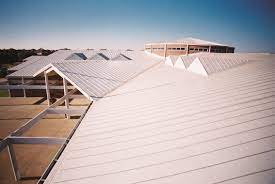There has been PVC roofing in the roofing industry for a very long time, but it is mainly used for commercial roofing projects. Despite its popularity for commercial buildings, it can also be used on residential buildings.
However, many homeowners do not know what a PVC roofing membrane is. Since it’s used only on specific areas of residential roofs, it’s understandable.
PVC roofing is a solid material, but if you have a roof that requires a membrane, you should know some truth about it to make an informed decision. You need not look any further since we have you covered. This guide is all about PVC roofing membrane in detail.
PVC roofing membrane
Roofing membranes manufactured from PVC (polyvinyl chloride) are used in residential and commercial applications. Because of the membrane’s white color, it reflects heat rather than absorbs it.
You should consider installing a PVC flat roof over a living space if it will keep the living space cooler. It is also a great alternative to non-living spaces such as garages or covered patios.
Just keep in mind the white membrane will eventually become dirty. A dirty PVC membrane can be seen from a window, but you must decide if it is a big deal.
If you choose a flat roofing material, there won’t be any functional issues, but it’s just something to keep in mind when choosing the right one.
The characteristics of PVC roofing
- PVC roofs have the advantage of being durable. The waterproof bond created by heat-welded seams makes this kind of membrane even more durable than the membrane itself, making it an excellent roofing membrane. Due to this unique property, PVC roofing doesn’t require any tape, adhesive, or caulk to seal its seams as other types of roofing do.
- Because their seams are welded, PVC roofs are highly resistant to winds. Sometimes, PVC roofs have even been able to withstand Category 3 hurricanes. Thus, if you live in an area prone to storms and strong winds, you might want to consider a PVC roof.
- The fire resistance of PVC is one of the main advantages of this type of roofing system, as it is challenging to ignite. Consider the fact that PVC roofs resist oxidization reactions very well. In comparison with other types of roofs, PVC is incredibly safe.
- As PVC roofing is chemically resistant, you don’t have to worry about roofing issues caused by chemical exposure. So, even when your flat roof is exposed to harsh chemical conditions, it can continue to serve you.
- PVC roofing systems also offer environmentally friendly characteristics. Solar energy is conserved by the high solar reflectivity of PVC membranes. Additionally, you will spend less money on heating and cooling your building.
Can PVC be used for roofing?
PVC roofs are built with durability in mind by engineers. The membrane of this robust material has a long lifespan since it was designed with robustness in mind. You won’t have to worry about repairing your roof again for at least another 20 years because most PVC roofs endure more extended than 20 years (source).
Advantages of PVC roofing membrane
Chemically and other hazards resistant
An exhaust vent on the roof of a commercial building can release harsh chemicals into the atmosphere, making PVC excellent roofing material. PVC is capable of withstanding frequent exposure to harsh chemicals without becoming damaged. With its strong membrane, PVC can withstand animal fat exposure and fire. This roofing material maintains a strong fire-resistance rating due to its slow-burning and ability to self-extinguish when a firefighter removes flame sources.
Disadvantages of PVC roofing membrane
Climate Change and Age Are Problems
Even though PVC roofs can last up to 20 years, additional repairs may be necessary once they reach ten years old. PVC that is eight or more years old can be hard to repair. Older roofs suffer from hot air weld failures, and the sealants wear away more quickly after application. However, if your roof is in excellent general condition, experienced contractors can overcome these challenges.

